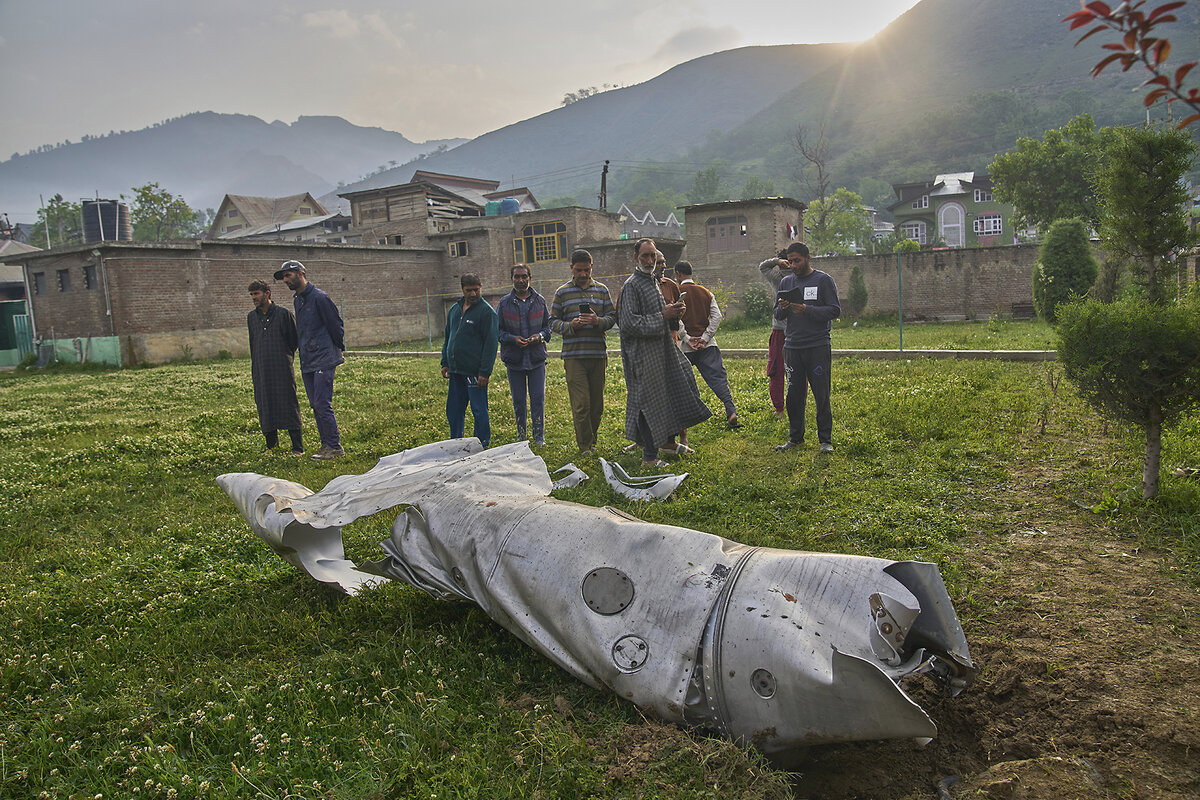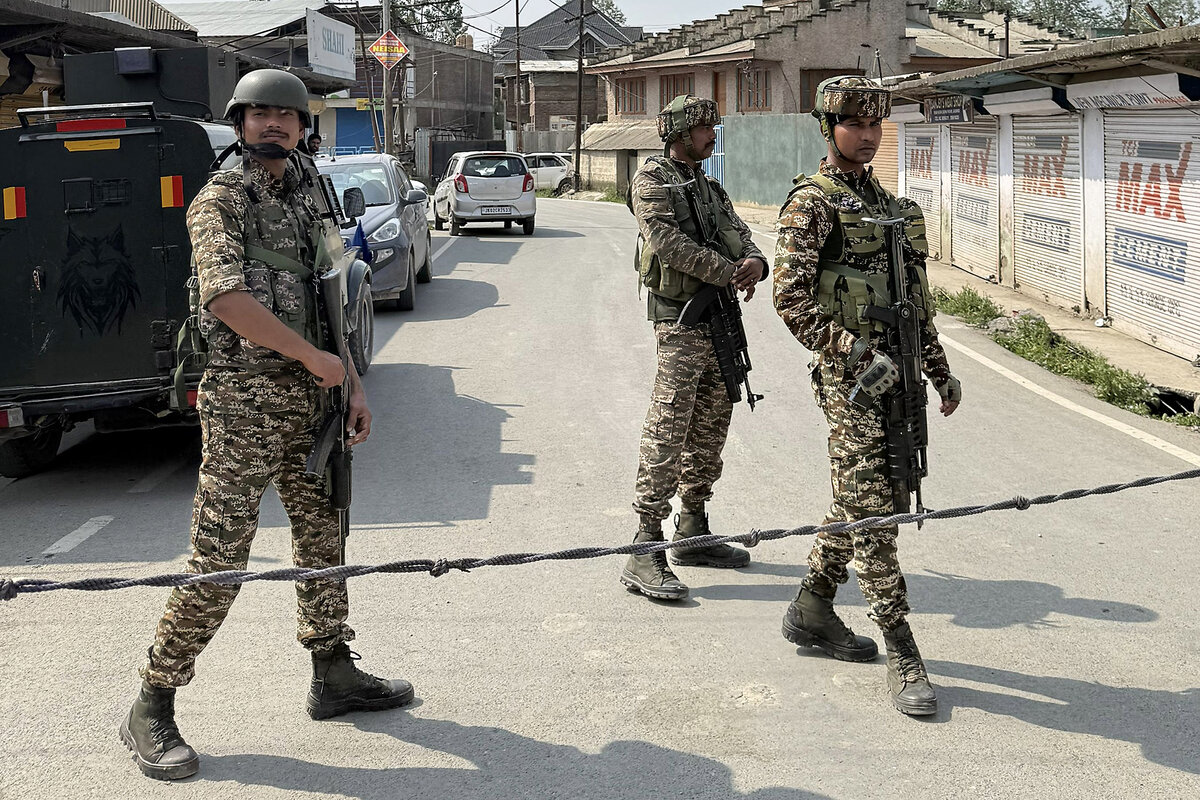India and Pakistan have fought before. Why this skirmish has the world on edge.
Loading...
| Srinagar, India
The series of missile strikes that India launched in Pakistan Wednesday is a worrying sign of military boldness that could dramatically up the stakes in the long-simmering tensions between nuclear-armed rivals.
India says the strikes, known as “Operation Sindoor,” were in retaliation for a recent militant assault in India-controlled Kashmir and are aimed specifically at “terrorist infrastructure” used to train militants and plan attacks against Indian citizens in Kashmir. They have triggered aerial skirmishes across the Line of Control (LoC) – the de facto border dividing the disputed Kashmir territory – and mark the most significant escalation of India-Pakistan tension since 2019.
But this time India appears even more emboldened. It hit not only sites in Pakistan-controlled Kashmir but also two locations in Pakistan’s Punjab province across the official, international border between the two countries. It’s the deepest point in Pakistan that India has attacked since the Indo-Pakistani war of 1971. Pakistan Prime Minister Shehbaz Sharif described the operation as “an act of war” and vowed to retaliate.
Why We Wrote This
World leaders urge calm as India-Pakistan relations deteriorate to their worst state in six years. The scope of India’s attacks and vows of retribution from Pakistan have many in Kashmir preparing for the worst.
Walter Ladwig, senior lecturer in International Relations at the King’s College London, says India’s actions suggest it’s “no longer willing to tolerate terror attacks as a strategic nuisance,” and that the old model, where elements of the Pakistan military could exploit the gray zone “between terrorism and war,” is collapsing.
“It may make future crises more frequent – and more dangerous,” he says. “Without diplomatic back channels or de-escalation tools, this relationship is likely heading toward a prolonged cold hostility, punctuated by sharp military episodes.”
Violence breaks out
The last time the two countries were on the brink of war was in February 2019 after a suicide bombing by a Kashmiri militant killed 40 Indian soldiers. The Pakistan-based Jaish-e-Mohammed outfit claimed responsibility, and India responded with what they described as airstrikes on terrorist camps in the northern town of Balakot, Pakistan.
That conflict eventually fizzled out, partly due to United States intervention, and India-Pakistan relations have generally remained frozen since. Then, on April 22, in a serene meadow of south Kashmir’s Pahalgam town, a group of militants opened fire on tourists. Within a few minutes, 26 civilians, including a local guide, were dead.
In the aftermath, Indian Prime Minister Narendra Modi assured revenge. Though no group has officially claimed credit for the Pahalgam attack, India has long accused Pakistan of backing proxy militant groups and funding cross-border terrorism – claims Islamabad rejects.
Across the border, Pakistan military spokesman Ahmed Sharif Chaudhry reports that at least 31 people have died in India’s Operation Sindoor. He says the strikes only hit civilian homes and mosques. Pakistan also claims to have shot down five Indian warplanes since the operation, but these claims have not been verified.
“One can characterize the situation as a limited military conflict at this point,” says Indian political scientist Sumantra Bose, who authored “Kashmir at the Crossroads: Inside a 21st Century Conflict.” “The real question now is whether it will escalate further.”
Pakistan finds itself balancing competing pressures, he adds: “On one hand, there will be public outrage on the streets; on the other, diplomatic calls for calm from various quarters, including the United States, China, the United Nations, and others.”
Kashmiris trapped in the crossfire
The fighting has already shattered the fragile peace that existed for years along the LoC, where people huddled into safety shelters and bunkers early this morning to escape artillery shelling.
Manzoor Hussain Kohli spent hours shuttling his extended family from a remote border village in Poonch to Surankote, a town about 20 miles away, trying to put a bit of distance between them and the shelling. He had to make three trips. “We are worried that if the [India-Pakistan] situation worsens, civilians will bear the brunt,” he says.
Per Indian officials, 15 civilians have been killed and 43 injured along the LoC and international border in Pakistan’s “arbitrary firing, including artillery shelling” after Operation Sindoor. The government has also shut down 18 airports and several schools along the Pakistan border.
Even miles away in the capital of Srinagar, many residents stayed awake throughout the night, listening to fighter jets fly over Kashmir’s skies and scrolling social media feeds for any updates about the strikes and cross-border shelling. In the morning, people across the valley crowded gas stations and markets, rushing to stock supplies in case the conflict escalates.
For Kashmiris, Mr. Ladwig explains, the ongoing escalation means more violence, more fear, and fewer avenues for political expression. “Regionally, every flare-up chills cross-border trade, damages investor confidence, and gives extreme voices across the subcontinent more leverage,” he says.
A world watching
This escalation has also drawn the attention of international stakeholders who are increasingly worried about South Asia’s stability.
China on Wednesday urged India and Pakistan to exercise “maximum restraint” in the interest of regional peace, following India’s missile strikes. U.S. President Donald Trump called the escalation a shame, and urged the two countries to sort it out.
The situation underscores how bilateral tensions between India and Pakistan have global ramifications, especially in a world fatigued by war in Ukraine and Gaza. As both nations weigh their next moves, pressure from powerful diplomatic actors may be the only immediate brake on further escalation.
Dr. Bose says there is currently a mood of triumph in India, but that may not last. “Despite how divided the world may seem today, there is a rare point of consensus from Donald Trump to Xi Jinping and many others that this conflict should not go any further,” he says. Because nobody wants, nor can afford, a third major regional war.






